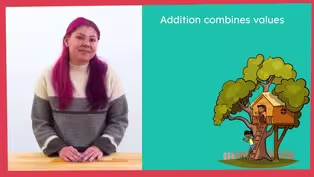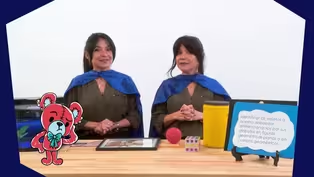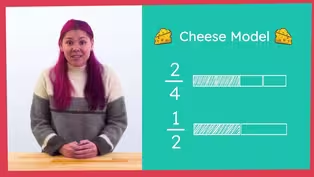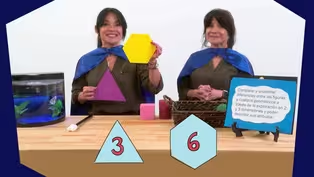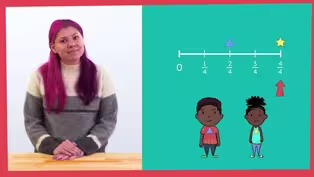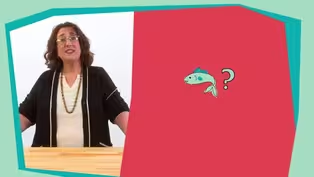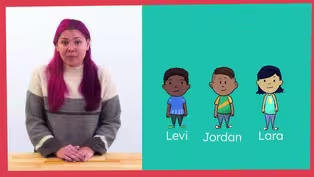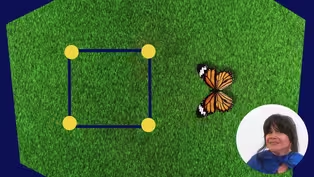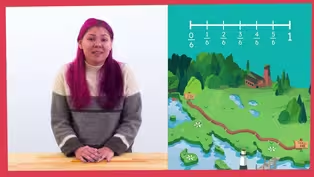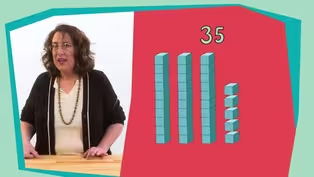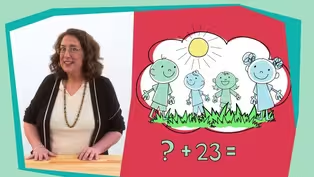
Episode 25 | Math Lessons
4/12/2021 | 28m 46sVideo has Closed Captions
Math lessons for early learners, led by NC teachers.
The first lesson (aimed at PreK-K learners) introduces students to matching and counting strategies. The second lesson (aimed at 1st-2nd graders) helps learners use mental math to solve equations. Classroom Connection is your At-Home Learning companion where children love to learn. All lessons are led by NC educators.
Problems playing video? | Closed Captioning Feedback
Problems playing video? | Closed Captioning Feedback
At-Home Learning Presents: Classroom Connection is a local public television program presented by PBS NC

Episode 25 | Math Lessons
4/12/2021 | 28m 46sVideo has Closed Captions
The first lesson (aimed at PreK-K learners) introduces students to matching and counting strategies. The second lesson (aimed at 1st-2nd graders) helps learners use mental math to solve equations. Classroom Connection is your At-Home Learning companion where children love to learn. All lessons are led by NC educators.
Problems playing video? | Closed Captioning Feedback
How to Watch At-Home Learning Presents: Classroom Connection
At-Home Learning Presents: Classroom Connection is available to stream on pbs.org and the free PBS App, available on iPhone, Apple TV, Android TV, Android smartphones, Amazon Fire TV, Amazon Fire Tablet, Roku, Samsung Smart TV, and Vizio.
Providing Support for PBS.org
Learn Moreabout PBS online sponsorshipMore from This Collection
Math lessons for early learners, led by NC teachers.
Video has Closed Captions
Math lessons for early learners, led by NC teachers. (28m 46s)
Video has Closed Captions
Math lessons for early learners, led by NC teachers. (28m 46s)
Video has Closed Captions
Math lessons for early learners, led by NC teachers. (28m 46s)
Video has Closed Captions
Math lessons for early learners, led by NC teachers. (28m 46s)
Video has Closed Captions
Math lessons for early learners, led by NC teachers. (28m 46s)
Video has Closed Captions
Math lessons for early learners, led by NC teachers. (28m 46s)
Video has Closed Captions
Math lessons for early learners, led by NC teachers. (28m 46s)
Video has Closed Captions
Math lessons for early learners, led by NC teachers. (28m 46s)
Video has Closed Captions
Math lessons for early learners, led by NC teachers. (28m 45s)
Video has Closed Captions
Math lessons for early learners, led by NC teachers. (28m 46s)
Video has Closed Captions
Math lessons for early learners, led by NC teachers. (28m 45s)
Video has Closed Captions
Math lessons for early learners, led by NC teachers. (28m 46s)
Providing Support for PBS.org
Learn Moreabout PBS online sponsorship[cheerful upbeat music] ♪ - What's up my super learners.
It's another great day to learn and play.
But before we get started, let me see you right that way, come on.
There it is, I like that.
I'm so excited you're tuned in the Classroom Connection, this is the world beyond the classroom where we connect to the world right at home.
We got some math, we got some reading, but also we got some of the dopest corners in the world coming to you all in the next 30 minutes.
Are you ready?
Me too.
Let's see that way one more time.
Yeah, there go, let's do it.
[bright upbeat music] - Hello, super learners, Ms. M here, I'm so glad that you are here today.
Are you ready for another math adventure?
Well, let's get started with a song.
[bright upbeat music] ♪ Hello super learners, how are you?
♪ ♪ Hello super learners, how are you?
♪ ♪ I'm so glad you're here today, ♪ ♪ and I hope you feel the same, ♪ ♪ hello super learners, how are you?
♪ I feel wonderful today super learners, and I hope you do too.
♪ Now it's time for our math power warm ups, ♪ counting up to 20.
Are you ready cause here we go.
♪ One, two, three, four, five, six, seven, ♪ ♪ eight, nine, 10, 11, 12, 13, 14, 15, ♪ ♪ 16, 17, 18, 19, 20, that was fun.
♪ Let's count to 20 again.
Are you ready to get snap counting with me?
Let's do it.
One, two, three, [snapping] four, five, six, [snapping] seven, eight, nine, [snapping] 10, let's keep going 11, 12, 13, [snapping] 14, 15, 16, [snapping] 17, 18, 19, [snapping] 20, yes super learners are the best.
I'm getting all warmed up, and I hope you are too.
One more time count up to 20, but this time let's do it in Spanish.
[speaking in foreign language] 20, excellent.
Great job, super learners.
Now it's time to review our colors.
Let's say them in English and Spanish.
[speaking in foreign language], red, [speaking in foreign language], orange, [speaking in foreign language], yellow, [speaking in foreign language], green, [speaking in foreign language], blue, [speaking in foreign language], purple, [speaking in foreign language], brown, [speaking in foreign language], black, [speaking in foreign language], white, [speaking in foreign language], gray.
Look for these colors in the world today.
And now it's time for our last math power warmup, the shape game.
You will see a shape and then you say its name in English or Spanish [speaking in foreign language], square.
[speaking in foreign language], circle, [speaking in foreign language], triangle, [speaking in foreign language], rectangle, [speaking in foreign language], rhombus, [speaking in foreign language], trapezoid, [speaking in foreign language], hexagon.
[speaking in foreign language], cube, [speaking in foreign language], corn, [speaking in foreign language], cylinder, [speaking in foreign language], sphere, mathtastic.
We have finished all our math warmups.
So now it's time for our ♪ math mission of the day, ♪ come on, let's check in with Sparkles the fish to see what our mission is today.
[bright upbeat music] Here it is, thank you Sparkles, let's read.
Dear super learners, your mission today is to compare two groups of objects to see which group has more or less.
There are for group comparisons to solve today.
All right, super learners, I know we can do this mission.
[bright upbeat music] Capes on.
Math power up, let's go.
[bright upbeat music] Here is our first challenge super learners.
There are two different groups of marshmallows up on the screen.
I wonder which group has more.
Group A or group B?
Which one do you think has more?
[bright upbeat music] Well, let's find out.
Let's count group a first, one, two, three, four, five.
There are five marshmallows in this group.
Now let's count Group B.
One, two, three, four, five, six, seven.
There are seven marshmallows in Group B.
So which group has more?
[bright upbeat music] Yes, Group B has more than group A, seven is more than five.
Let's take a closer look.
Looking back at the screen if you line the marshmallows up in Group A like this.
Now let's line up the group of marshmallows from Group B like this.
Group B's line is longer.
Let's check our work another way.
This is a five frame.
It is a math tool that helps us make sets of five.
When a five frame is full, we know that we have a set of five.
Let's use a five frame to compare the sets.
Math power up.
[Bright upbeat music] Group A first.
One, two, three, four, five.
Wow, group A fills a whole five frame.
Now Group B, one, two, three, four, five, six, seven.
Group B filled a five frame and had two left over.
Group B definitely has more marshmallows than Group A.
So seven is more than five.
Yes, we could also say five is less than seven.
Amazing job super learners.
Let's move to the next two groups.
Oh, look, two different groups of pennies.
Which one do you think has more?
Look at it.
Group A or group B?
[bright upbeat music] Yes, Group B.
How did you know that?
Oh, you looked at the groups of objects and saw without counting which one had more.
Whoa, you just use a really super math power called Subitizing.
Subitizing means knowing how many without counting.
That is great work super learners.
Now let's count the two groups to check our subitizing skills.
We'll use the five frame again to help us.
Okay, group a first, one, two, three.
This group has three, it does not fill the five frame.
Now Group B, one, two, three, four, five.
Group B fills the five frame.
There are five pennies in this group.
So which group has more?
Yes, group B has more pennies than group A.
Five is more than three, or we could say three is less than five.
Great job super learners, two challenges complete.
I'm ready for a math movement break, are you?
You are, then let's move.
We're going to act on a mass story.
The story will tell you how and when to move.
Let me get my little friend here.
Once there was a bear, who wanted to go to the field to eat berries, the bear took three hops towards the berries.
Ready?
Let's hop three times, one, two, three.
Then the bear took five giant steps towards the berries.
Let's take five giant steps, one, two, three, four, five.
Next the bear took eight jumps towards the berries.
We know what to do, let's jump eight times.
One, two, three, four, five, six, seven, eight.
Finally the bear reached the berries.
The bear was so hungry that the bear ate 10 berries.
Let's eat the berries, one, two, three, four, five, six, seven, eight, nine, 10.
After all that eating, the bear took one big stretch like this.
[groaning] And then the bear was full and happy and took a nap.
[bright upbeat music] That was great.
Wow, super learners, I feel ready for our next math comparison challenge, I hope you are too.
Math power up.
Look up at the screen, here are two more groups, pompoms this time.
Just by looking at them, can you tell that these groups are bigger?
You can, yes.
The groups of pompoms are much larger than the groups of pennies and marshmallows.
I think it's time for another math tool.
We already know what a five frame looks like.
Now here is a 10 frame.
A 10 frame has 10 boxes instead of five.
If the 10 frame is full, then we know we have at least a set of 10.
Let's count group A.
One, two, three, four, five, six, seven, eight, nine, 10, 11, 12, 13, 14.
Group A fills a 10 frame, and it has four more pompoms for a total of 14.
Now let's count Group B.
One, two, three, four, five, six, seven, eight, nine, 10.
Group B has exactly 10.
So which group has more?
[instrumental music] Yes, group A has more, 14 is more than 10, or we could say 10 is less than 14.
Okay, super learners, here is our final challenge.
Here are two groups of color tiles, again, the groups look larger, so let's use a 10 frame to help us again.
Group A first, one, two, three, four, five, six, seven, eight, nine, 10, 11, 12, 13, 14, 15, 16, 17.
Wow, 17, one full 10 frame plus seven more, 17.
It almost filled two 10 frames.
Now Group B, one, two, three, four, five, six, seven, eight, nine, 10, 11.
11, one full 10 frame plus one more is 11.
So which group has the most pompoms super learners?
Yes, Group A, 17 is more than 11, or we could say 11 is less than 17.
Great job super learners, we have completed all four comparisons.
We used the math tools called a five frame, and a 10 frame to help us count and compare the groups of objects.
Let's check back with Sparkles the fish.
[instrumental music] Mission complete, hurray.
Congratulations super learners, you used your math powers and completed the mission.
Now what is it time to do?
Let's review.
Today we compared groups of objects to see which group had more, and which group had less.
We used the math tools of a five frame and a 10 frame to help us count the objects.
We also used the special math power of subitizing or knowing the number of objects without counting for smaller groups.
Practice comparing groups today super learners, count different things around you and see which things have more and less.
You can share your math power by showing it to someone.
Thank you super learners for going on a math mission with me today.
Sparkles, thanks you too.
Remember, you have the power to be super at math.
Bye, [speaking in foreign language], math power out.
- I hope you love numbers even more now after that awesome lesson.
Do you have a favorite number?
I like eight, why?
Because it's the Chinese number for good fortune.
Numbers can be beautiful, just like words.
- Hi, my name is Dayvon, and I'm gonna read Shapes That Roll.
[slow music] Shapes that roll, shapes that can't.
Shapes with sides that angle and slant.
[slow music] Some shapes stack, some shapes don't.
Watch out, eggs and balls are shapes that won't.
Shapes to throw, shapes to share.
Shapes that dangle in the air.
[slow music] Shapes for stop, shapes for go.
A house has many shapes to show.
Shapes that shine, shapes that freeze, shapes of fruits that grow on trees.
Shapes that glimmer up above, shapes that make you think of love.
Shapes to open, shapes to close, shapes that stand upright in rows.
Shapes that titter, shapes that play.
Shapes help people find their way.
A shape that's whole, a shape in pieces.
Shapes with many folds and creases.
[slow music] Shapes are heavy, shapes are light.
Pillow shapes are sure to fight.
Spheres are round, circles are flat, squares lie down, and cubes are fat.
Now, you know shapes, how cool is that?
- Today's affirmation is, I am passionate, powerful, and productive.
Say with me, I am passionate, powerful, and productive.
I am passionate, powerful, and productive.
I am passionate, powerful, and productive.
- The longest french fry ever recorded was 34 inches long.
Yo, that's probably bigger than some of you at home right now.
Math helps us measure height, distance, and so much more.
So let's get into that math lesson right now.
[bright upbeat music] - Hi, friends, I am very happy to be here with you today, and I brought my friend Splat with me.
My name is Dawn, and today we are going to have math fun with a number talk.
Number talks help us practice solving math problems in our head.
Today, we are going to practice using friendly numbers to help us solve problems mentally, or in our head.
Friendly numbers are numbers that have zeros and the ones place like 10 or 20 or 30.
That make it easy to add on so we can figure out the answer.
We might even need to decompose or break apart a number to help us get to our friendly numbers.
Remember, there are so many ways to solve math problems and Splat and I want to help you find the strategy that works best for you.
We are going to use a chart like this to organize our thinking.
We will add math problems to each box, and show our thinking on how we solved these problems.
Before we get started, you might want to gather a few items to help you today.
You might want to get a stuffed animal or trusted adult to talk to so you can explain your thinking.
You can also tell Splat.
You also might want to get some paper and pencil or notebook to write down your learnings at the end of our time together.
This could be your math journal.
I'll give you a few seconds to go gather your materials.
[bright upbeat music] Welcome back.
I hope everyone was able to gather what they needed.
Addition, we hear that word a lot, but do we think about what it really means?
Let's use a frayer model to think about it some more.
Let's take a piece of paper and fold it in half hamburger style.
And then fold it in half again to make four equally sized rectangles.
Then in the corner of our paper where all the sides are folded, we'll fold down a small triangle.
When you unfold your paper, the fold should look like this.
Does yours look like mine?
Okay, great.
We're going to write addition in the center diamond because this is the word we need to understand more about.
Then in the upper left rectangle, we're going to define or write what addition means.
So let's write the word definition here.
Okay, great.
In the upper right rectangle, we're going to provide an example of addition.
So let's try an example here.
Then in the lower left rectangle, we'll provide a non-example or what addition is not.
So let's write non-example here.
And finally, in the lower right rectangle, we'll draw a picture to help us visualize what addition is.
So let's write picture here to remind us of what we're supposed to do.
[bright upbeat music] Now we're going to define addition together.
So let's think and then write the definition in our upper left rectangle.
So Splat and I are outside in the North Carolina mountains picking apples.
We would combine his basket of apples and my basket of apples into one big basket and count to see how many we have in all.
This would be addition.
So addition is when we join groups of objects together.
Splat and I are gonna give you some time to write this definition in your frayer model.
[bright upbeat music] As we learn more about addition in today's lesson, you will be able to add examples, non-examples, and draw a picture to show your growing understanding of addition.
Are you ready to get started?
Splat is, so let's go.
Here's our first expression, 30 plus four.
I want you to think in your head, how you would solve this.
Would you tell an adult or stuffed animal your answer?
[bright upbeat music] I bet you told an adult or stuffed animal that the answer is 34, that's correct.
Will you explain to me about how you solved this in your head?
[slow music] Splat and I heard someone say that they knew that 30 was already a friendly number.
So they added four ones to it and made 34.
That is awesome thinking.
I think we're ready for the next one.
Here it is, 29 plus four.
Will you solve this problem in your head?
[slow music] Tell an adult or stuffed animal what you think the answer is and Splat whisper to me.
[slow music] Splat whispered to me that the answer is 33.
Is that what you said?
Great thinking.
Now, can you tell an adult or stuffed animal how you know the answer is 33?
I heard someone say that they know that one and three make up four.
So they broke apart the four into one and three, and added the one to the 29.
29 plus one got them to the friendly number of 30 or three tens.
Then they had three ones left over, and 30 plus three equals 33.
That's really great thinking on how you get to a friendly number to help you find the answer.
You are really getting the hang of this.
Let's try another one, 29 plus 14.
Oh, this is a big one but i know you can do it.
Think in your head about what the answer is.
[slow music] Now will you tell Splat what you think the answer is?
[slow music] Yes, 43, that's correct.
Will you tell me how you figured out the answer?
[slow music] Wait, what Splat?
Splat said he thought about this on a number line, and we'd like for me to show you that thinking using a number line.
I think that's a great idea.
If we have an open number line, we will begin at our biggest number which is 29.
Now we have to jump to 14, but that's a lot to do in our heads.
So we can decompose that number.
First we jump one and we land on a friendly number, and that number is 30.
Now we have 13 left to jump.
So we jump 10 more, and we land at 40, another friendly number.
Then we have three left to jump, and we land at 43.
So we decomposed 14 into one plus 10 plus three to help us get to friendly numbers easier.
That was a great idea splat had of showing our thinking on a number line.
Friends it's been so fun to do mental math and number talks with you today.
Splat and I had such a great time decomposing numbers with you to help us get to friendly numbers.
Getting to friendly numbers helps us add easily and quickly in our brains.
But before we go, Splat and I would like to hear what you learned in your own words.
I have this sentence starters, and I'm hoping you can finish these sentences with me.
They say today in math i learned, and i can.
So i might say, today in math i learned how to use friendly numbers to make adding larger numbers easier.
I can decompose a number into smaller numbers.
This helps me get to a friendly number first, and then add on to find my sum.
Now it's your turn, read this with me and finish it by telling an adult or stuffed animal.
Today in math i learned, [slow music] great job.
And now let's read our next sentence starter and you can finish it.
I can, [slow music] that was great thinking.
Now that you've said your sentences out loud, you can write them on your paper or in your notebook to create a math journal of your learning.
Splat and I also want to continue on our frayer model to show our learning about addition.
We want to add an example of what addition is to our paper.
You might say an example of addition is five plus five since this would be an example of adding two groups of five together.
We'll give you time to add that to your paper.
[instrumental music] For non-example or what addition is not, we could write 10 minus five since this is subtraction and not addition.
Go ahead and add that now.
[instrumental music] Next, Splat and I challenge you to add a picture that shows what addition is to your paper to help show your understanding of what we did today.
You can also add more examples and non-examples of addition.
Then you can share your learning with a trusted adult or stuffed animal.
Splat and I must be going now.
You did a great job thinking about numbers, and decomposing them and explaining your thinking.
Keep solving math problems in your head, and maybe Splat and I will see you soon.
[bright upbeat music] - [Narrator] Once upon a time, an Imagifriend sat in his bed late at night feeling worried and scared.
He had an uneasy feeling all day and he couldn't sleep well.
Suddenly he looked to the nice sky from his window and saw Lucia flying over him with all of her magnificent colors.
With the sight of her he became instantly calm.
He waved at Lucia from his window, and Lucia smiled and winked at him just before disappearing into the night sky.
When you live carefree the sky's the limit and that's where you can find Lucia.
- What a cool math lesson.
I cannot wait for the next lesson, practice makes perfect they say but really I just like getting better one day at a time.
Each day is a new opportunity to learn and grow, and I'm glad we got to do it together.
[cheerful upbeat music] ♪


- Home and How To

Hit the road in a classic car for a tour through Great Britain with two antiques experts.












Support for PBS provided by:
At-Home Learning Presents: Classroom Connection is a local public television program presented by PBS NC
